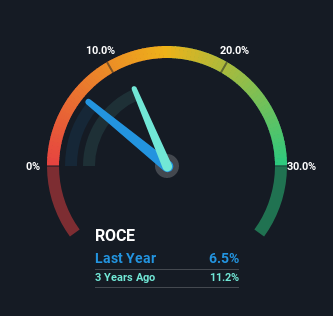- Hong Kong
- /
- Healthcare Services
- /
- SEHK:3689
Investors Could Be Concerned With Guangdong Kanghua Healthcare's (HKG:3689) Returns On Capital

Did you know there are some financial metrics that can provide clues of a potential multi-bagger? Firstly, we'd want to identify a growing return on capital employed (ROCE) and then alongside that, an ever-increasing base of capital employed. Put simply, these types of businesses are compounding machines, meaning they are continually reinvesting their earnings at ever-higher rates of return. However, after investigating Guangdong Kanghua Healthcare (HKG:3689), we don't think it's current trends fit the mold of a multi-bagger.
Return On Capital Employed (ROCE): What is it?
For those who don't know, ROCE is a measure of a company's yearly pre-tax profit (its return), relative to the capital employed in the business. Analysts use this formula to calculate it for Guangdong Kanghua Healthcare:
Return on Capital Employed = Earnings Before Interest and Tax (EBIT) ÷ (Total Assets - Current Liabilities)
0.065 = CN¥126m ÷ (CN¥2.7b - CN¥778m) (Based on the trailing twelve months to December 2021).
So, Guangdong Kanghua Healthcare has an ROCE of 6.5%. In absolute terms, that's a low return and it also under-performs the Healthcare industry average of 9.9%.
View our latest analysis for Guangdong Kanghua Healthcare

While the past is not representative of the future, it can be helpful to know how a company has performed historically, which is why we have this chart above. If you're interested in investigating Guangdong Kanghua Healthcare's past further, check out this free graph of past earnings, revenue and cash flow.
What The Trend Of ROCE Can Tell Us
In terms of Guangdong Kanghua Healthcare's historical ROCE movements, the trend isn't fantastic. Over the last five years, returns on capital have decreased to 6.5% from 16% five years ago. Although, given both revenue and the amount of assets employed in the business have increased, it could suggest the company is investing in growth, and the extra capital has led to a short-term reduction in ROCE. If these investments prove successful, this can bode very well for long term stock performance.
Our Take On Guangdong Kanghua Healthcare's ROCE
In summary, despite lower returns in the short term, we're encouraged to see that Guangdong Kanghua Healthcare is reinvesting for growth and has higher sales as a result. But since the stock has dived 79% in the last five years, there could be other drivers that are influencing the business' outlook. Therefore, we'd suggest researching the stock further to uncover more about the business.
On a final note, we found 3 warning signs for Guangdong Kanghua Healthcare (1 can't be ignored) you should be aware of.
If you want to search for solid companies with great earnings, check out this free list of companies with good balance sheets and impressive returns on equity.
New: Manage All Your Stock Portfolios in One Place
We've created the ultimate portfolio companion for stock investors, and it's free.
• Connect an unlimited number of Portfolios and see your total in one currency
• Be alerted to new Warning Signs or Risks via email or mobile
• Track the Fair Value of your stocks
Have feedback on this article? Concerned about the content? Get in touch with us directly. Alternatively, email editorial-team (at) simplywallst.com.
This article by Simply Wall St is general in nature. We provide commentary based on historical data and analyst forecasts only using an unbiased methodology and our articles are not intended to be financial advice. It does not constitute a recommendation to buy or sell any stock, and does not take account of your objectives, or your financial situation. We aim to bring you long-term focused analysis driven by fundamental data. Note that our analysis may not factor in the latest price-sensitive company announcements or qualitative material. Simply Wall St has no position in any stocks mentioned.
About SEHK:3689
Guangdong Kanghua Healthcare Group
An investment holding company, primarily operates private hospitals in the People’s Republic of China.
Excellent balance sheet low.


